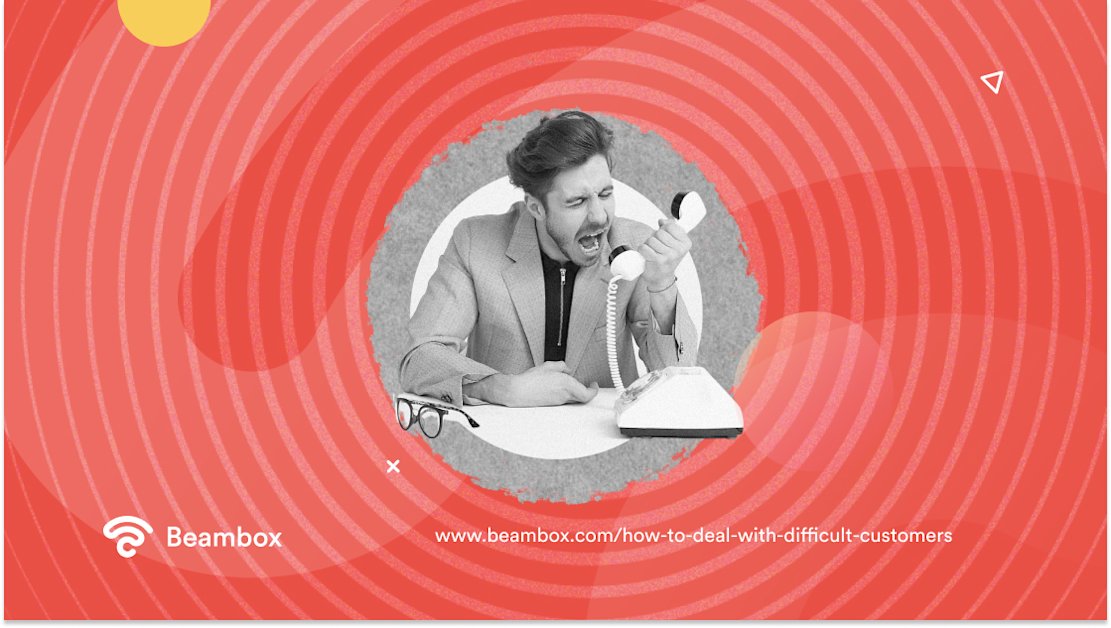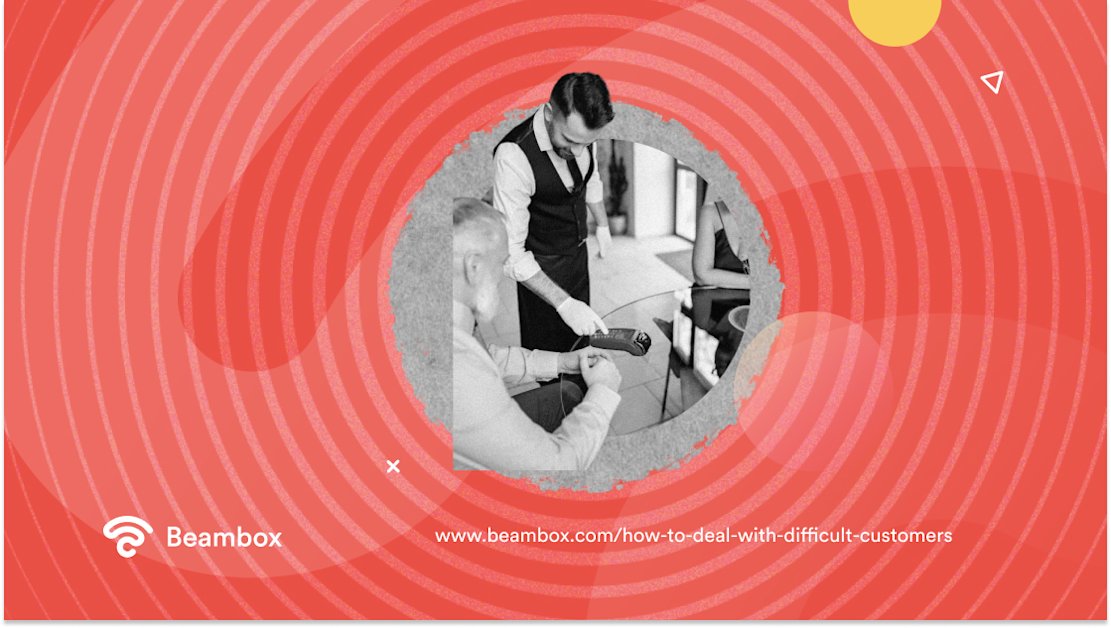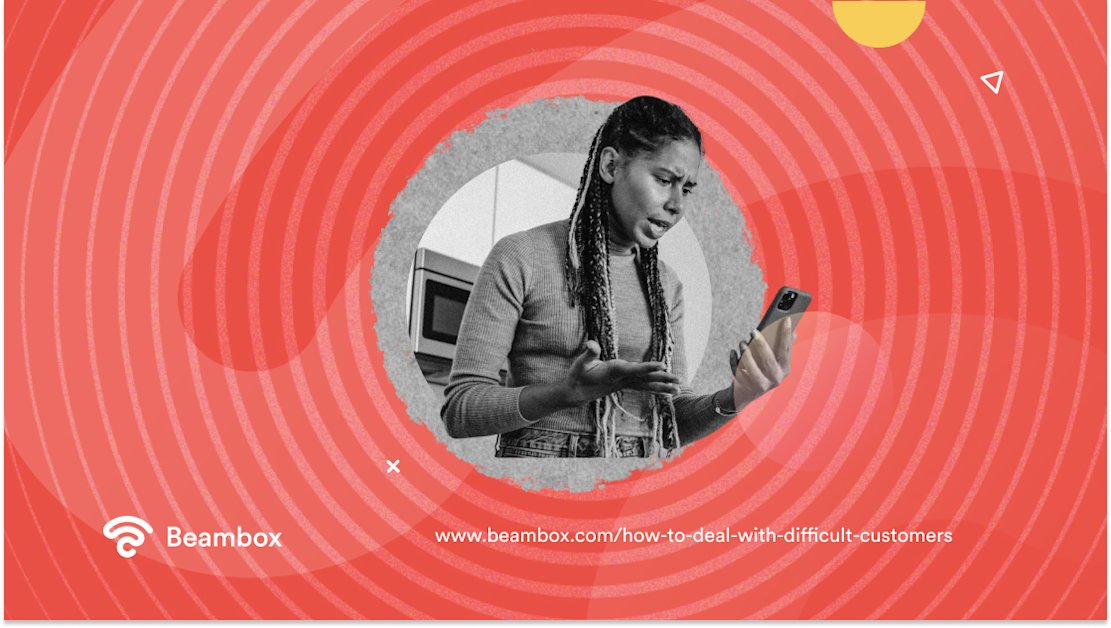How To Deal With Difficult Customers With Practical Examples
Even businesses with excellent products and customer service sometimes find themselves facing a difficult customer. Everyone has a bad day once in a while, and that reflects when they talk to you. Or they’re just very hard to satisfy. In any case, learning how to deal with difficult customers is a must.
Your instinct might tell you to give rude customers a piece of your mind or ignore them entirely. However, they’re the ones bringing in the money. So, don’t lose your temper here and approach the situation professionally.
Moreover, solving difficult customer situations gives others the impression that you care about your customers. That might bring you more audience!
It shows that you know what you’re doing and are capable enough. Besides, nobody likes doing business with someone who loses their cool in tricky conditions. So, if you’re ready to achieve customer loyalty, this is the perfect place to start.

How To Deal With Difficult Customers on the Phone?
When doing any business, you’ll have to face difficult customers through various mediums. Sometimes, it will be a customer calling on the phone or coming directly to your venue to file a complaint. Other times, they’ll show their anger in emails, social media DMs, and even negative reviews!
Now, because you’ll judge the anger level of each customer depending on the medium, the strategy also varies slightly. Let’s start with discussing how to deal with difficult customers on the phone.
Here, you can’t physically see them. But you can hear their voice, and with enough customer service skills, you can analyze the situation through the tone.
If the customer is accusing you, don’t take it personally. Keep calm and let them speak. Don’t interrupt or try to cut them because active listening is the first step to solving any difficult situation.
Once they’ve spoken, kindly apologize to them and state that you understand their problem. It would also be a good idea to repeat it to prove that you’ve listened and are ready to help.
With this step, the customer might’ve calmed down a little bit. This is your chance to offer a solution. But don’t enforce anything and give them a chance to make their own choice. Also, keep your use of “you” to the minimum; otherwise, it will sound like you’re blaming them.
Lastly, end the call on a positive note. For example, imagine you are dealing with a negative review on Google. You might say, “Thank you for taking the time to give your feedback. We’ll do our best to resolve this issue as soon as possible.”
How To Deal With Difficult Customers in Retail?
Now that you know the basics of dealing with difficult customers, it’s time to get specific. Let’s get more specific on how to deal with difficult customers in retail.
Keeping your inventory updated, cleaning shelves regularly, and looking after the general retail operations will work in your favor. Another issue that fires up arguments is not having a return or refund policy. So, allow customers at least seven days to return a product, provided they haven’t used it.
However, things won’t always be ideal. Even if you’ve taken all the measures, someone might still get upset over something.
When you’re running a retail business, chances are you’ll be dealing with angry customers face to face. This is the beginning of customer attrition, and it might harm your business.
While the main rules here will be the same as dealing on the phone, you can use hand gestures, too. But there is a thin line between aggressive and kind body language. So, remain on the positive side of that line. Otherwise, the situation might escalate out of control.
Moreover, smile when appropriate, for example, when you’re offering a solution. Smiling when the customer is angrily stating the problem isn’t wise.
Now, what type of solutions can a retail business offer? Firstly, you might give them extra loyalty points, discounts, or vouchers. Secondly, a personalized apology from the manager or someone of equal rank will work wonders.
Lastly, you must also follow all of the tactics for dealing with difficult customers on the phone.

4 Tips To Deal With Difficult Customers
Earlier, we mentioned that how you deal with difficult customers depends slightly on the medium. However, some things won’t change, no matter if you’re replying to an online review, live chat, or on the phone.
Whether or not you follow these common rules can make or break the situation. Moreover, if you employ people, include these tips as part of their training. For example, if you run a retail, this should be part of your retail employee training program.
So, here are the four best tips for customer relationship management.
Tip #1: Empathize With Them
Let’s start with empathy, which works in all difficult situations, not just business. You must put yourself in the customers’ shoes here because anger is natural. If they’re investing money in something, they want it to be perfect.
Therefore, you can’t expect them to remain calm when they think they’ve wasted their money. Think about what you would do if you had a problem with the business you’re investing in.
Only then will you be able to keep an open mind and solve the customers’ problems.
Moreover, it’s your business, and you understand its ins and outs. But your customers don’t. It’s up to you to think of them as beginners and explain how things work. “Everybody knows that” isn’t the ideal mindset to approach difficult customers.
Lastly, avoid being defensive. Remember, it’s the problem that’s causing your customers to be angry. It’s nothing personal, and you’ve just become the target of their anger because you represent your business.
Tip #2: Repeat Their Issue To Demonstrate You’ve Understood
Once you’ve understood their problem with empathy, let them know. Repeat the problem and ask them if you’ve understood correctly. Here’s an example.
Suppose a customer writes, “I bought this shirt last week. I explicitly asked you if its color would fade, and you told me it wouldn’t. But when I washed it, the exact thing I was fearing happened. Look, the color has faded. What am I supposed to do now? I’ve wasted my money.”
Now, say the customer didn’t read the instructions, which is why the color has faded. But don’t say that yet. Instead, your response should be something like this.
“I apologize for the inconvenience this has brought you. You say you washed this shirt, and the color faded when it wasn’t supposed to, right?”
The customer will probably have calmed down a bit now since you apologized and understood their problem. However, remember to use the appropriate tone here. You don’t want them to think you’re accusing them of causing a scene.

Tip #3: Create Short Milestones of the Problem
This next tip might not apply in all situations. But sometimes, a problem might take time to resolve. You might have to go through several stages to achieve customer satisfaction. Here, creating short milestones for the problem will work wonders.
Firstly, it will make your work easier. It’s human nature to delay things that look like they’ll take too much time. But when you create small doable chunks of the problem, you’re more willing to start tackling it.
Secondly, you’ll be able to give regular updates to the customer. This will keep them at peace that you’re solving their problem. When customers don’t hear back from you, they might think you’re ignoring them even though you’re working on their problem.
But when you solve the problem in chunks, you can give them feedback about the problem’s status. Here’s how.
First, apologize and let them know you’re checking what the issue is. When you’ve found the root problem, let the customer know about it.
Also, tell them what you’ll do to solve it and keep informing them of the latest developments. Lastly, follow up and see if the customer is happy with your solution.
As an upside, consider that answering to negative reviews is one of the ways to get more reviews.
Tip #4: Do Not Let Emotions Take Over You
The last tip is not to let emotions take over you. It’s natural to avoid situations that make you uncomfortable. However, ignoring customers when they’re being difficult is not a smart move.
When trying to solve a difficult situation, you might fear making the customer even angrier. Or you might be afraid that they’ll stop doing business with you.
But letting go of this fear is necessary to solve the situation. Otherwise, you’ll end up giving an average apology, and the customer won’t have a solution. Here’s a hypothetical situation. Instead of saying, “We’re so sorry. It won’t happen again. Please give us another chance and keep doing business with us.”
Say, “I apologize that this has happened and understand how frustrating it is. Don’t worry, I’ll solve your problem by [state the solution] and appreciate your patience during the process.”

Examples of Dealing With Difficult Customers
Did you know that 60% of shoppers say they share their negative experiences with others? Well, that’s bad news for you because if you don’t resolve customer issues, they’re going to spread the news.
Needless to say, you’ll increase your customer churn after this. Therefore, learning to deal with difficult customers should be at the top of your priority list.
But there are various types of unhappy customers, and you must deal with each differently. So, here are three examples of dealing with difficult customers.
When It’s a Customer Who Always Complains
The first type of customer is the frequent complainer. They don’t hold back from filing complaints and stating their issues, often in an angry tone. Sometimes, these customers may even deliberately look for issues within the product or service.
For example, they might say something like this. “I am very disappointed. Whenever I order anything, you’re always making mistakes. This time, you’ve sent me the wrong product. Do you even know how to do business?”
As an instinct, you’ll find it annoying when the same customer keeps filing complaints. But don’t let that take over your cool. Stay calm and start the conversation by apologizing, even if it isn’t your fault.
When angry customers hear an apology, half of their anger usually melts away. Here’s an example response to the above complaint.
“I am so sorry for sending you the wrong product. Let me look into why this happened so that you get the service you deserve next time. Meanwhile, you can expect a new delivery with a special gift as an apology.”
When It’s a Customer Who’s About To Leave
You’ll know if a customer is about to leave when they mention interest in another competitor. Or they’ve had more than one bad experience with you and explicitly mention that they won’t do business anymore.
Here’s an example of how this customer might talk. “Is it just me, or is everybody having issues using your software? I can’t find [FeatureABC] anywhere. [CompetitorXYZ] is much better at solving these issues, and their software is easier to use, too. I don’t know why I keep coming back to you.”
In this situation, you must act quickly. Start by apologizing and guiding them throughout the process. For example, you might say:
“I apologize for the difficulty you’ve been facing when using our software. To find [FeatureABC], just head over to [place] and click “More.” There, you’ll find the feature you’re looking for. I’m right here if you’re still facing issues.”
Once you’ve solved that issue, keep them in the loop and give updates if you’ve made any changes. Plus, to stop them from leaving, offer discounts, packages, or additional upgrades.

When It’s a Customer With Impractical Expectations
The last example is a customer with impractical expectations. This is particularly true for hospitality businesses like fine dining restaurants. They ask for things outside the scope of your business and oftentimes become irritated when you can’t provide those things.
Confused customers might be a subcategory of this. You can recognize them when their conversations are vague, and they leave it to you to guess their problem. Here, you must ask lots of questions to help them understand their problem.
This category might say, “I have been dining at your restaurant for the last two months. Everything has been great, but why don’t I see any delicacies on your menu? Lobsters are my favorite, so add that to your menu.”
Here, your response should be something like this, “Thank you so much for trusting our restaurant for the last two months. We hope our relationship goes long, but we’re sorry to say that we can’t accommodate your request. Delicacies are not really our specialty for now. But have you tasted our loaded burger? It’s the most popular item and currently has a 15% discount.”
Turn an Inconvenience Into an Opportunity
Learning how to deal with difficult customers is not hard when you know the right protocols. One of the most important things is to keep your tone professional and calm.
Start your conversation by apologizing even when it’s not your fault. Moreover, you must understand their problem and possibly give them a solution.
If you want to improve your online reputation, try out Beambox. It helps you get more positive reviews on local review sites. Moreover, it can help you protect your rating by avoiding negative reviews getting online.
Over 12,000 businesses are using Beambox to improve their marketing and business results. Do you want to be next? Start your trial today!
Get Started With Free WiFi Marketing
Beambox helps businesses like yours grow with data capture, marketing automation and reputation management.
Sign up for 30 days free


